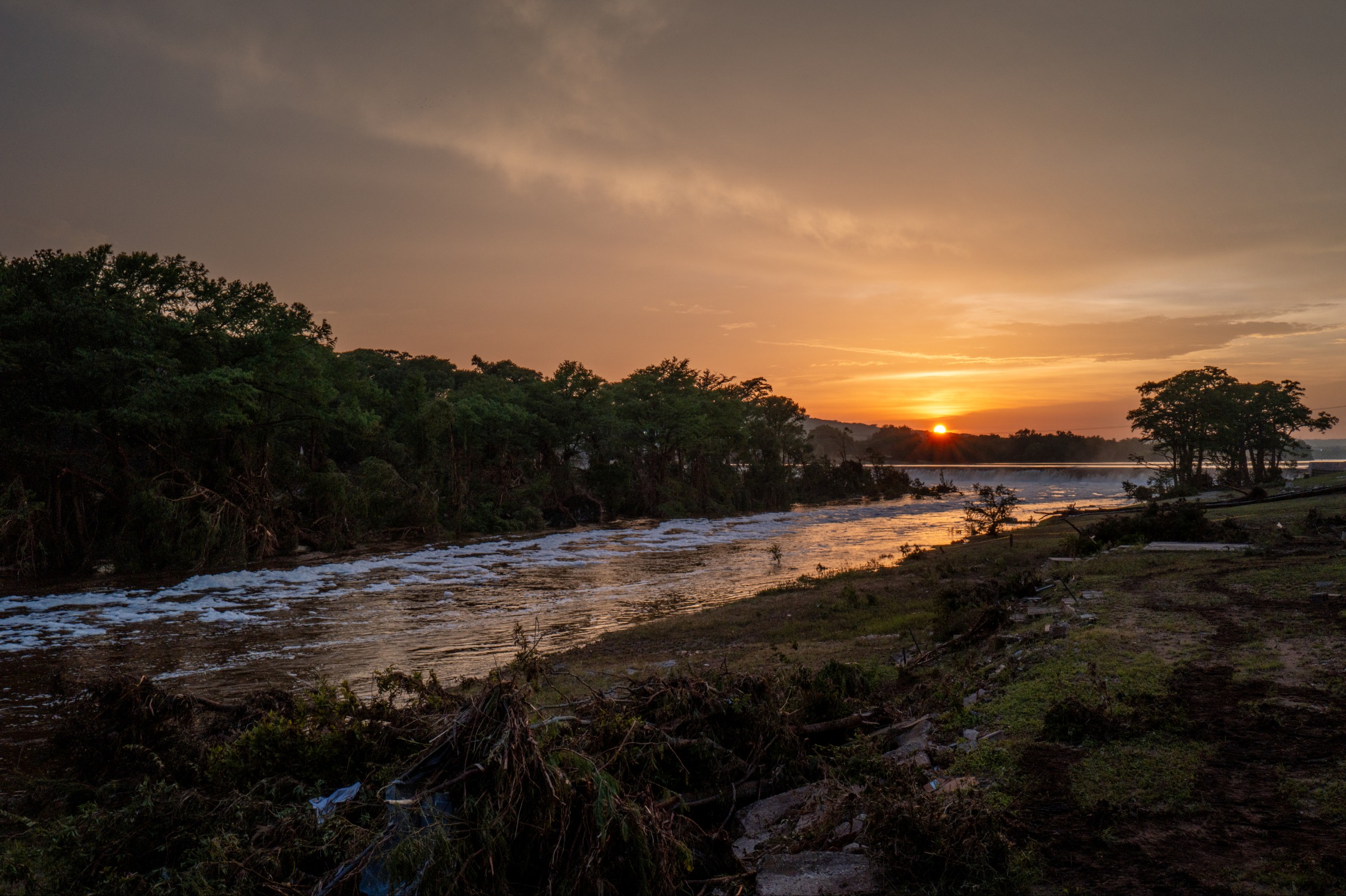It's easy to forget that God's covenant is limited. God makes a solemn promise to Noah that He will never flood the whole Earth again ... however. "Never again will I let floodwaters destroy all life," the Bible says He said. But He never promised that He wouldn't let the floodwaters destroy someone's life, or your life. He only promised they wouldn't destroy everyone's at once.
This weekend, a mammoth amount of rain fell on the Texas Hill Country. Some experts estimate as much as 15 or even 20 inches of rain fell in just a few hours. More than a literal foot of rain dumped from the sky, with very little warning. I remember storms like these, where it feels as if sheets of rain are pouring down, as if someone reached up with a Bowie knife and sliced open the swollen clouds. But where I grew up in Northern Texas, there is no beautiful winding river for all that water to funnel into like it did this weekend. All of that water, immense and terrifying, poured into the Guadalupe River and its tributaries. In my memory, the Guadalupe River is emerald green. It carves through limestone hills, and is dotted with cedar and oak and pecan trees. It is dotted with mountain laurel. This weekend, it was wrathful. It took all of that rain, and expanded, took the land as its own, broke down trees, swept away people and cars and pets and homes.
The storm traveled along the river's course, filling it more than if it had moved over some other watershed. A river that was 100 feet away was splashing on your toes 15 minutes later. A timelapse of the river rising near Kingsland shows a group of observers backing up as it rises. It’s easy to imagine one of them being caught unaware, or asleep, or with nowhere to escape to.
If you acted fast and moved to higher ground, ran from the river, you might survive. But many could not and did not. The flash flood came in the middle of the night; the initial National Weather Service alert for flash flooding for Kerr County went out at 1:14 a.m. It was the wee hours of Independence Day, which meant the small houses and cabins that dot the banks of the river were full of people on their long weekend. Even in a place colloquially known as Flash Flood Alley, this is a nightmare.
"At least," all the news reports say, because they know every number is temporary. At least 20, at least 30, at least 60, at least 81 people dead. Every day the death count rises because still people are missing, and when they are found, they add to the total. Forty adults and 28 children are dead in Kerrville alone. At Camp Mystic, an almost 100-year-old summer camp on the banks of the Guadalupe River, at least 27 campers and counselors are dead. The cabins closest to the river were full of young girls. The director of the camp, Dick Eastland, died trying to rescue them.
It’s hard to understand the scale of the destruction, even in photos. A car lies flipped over on a river bank. A few puddles dot a big field covered now with debris and trash. A massive old pecan tree lies humiliated on the side of the road, its roots splayed in the air. A pair of children’s stuffies sit muddied on the floor of a destroyed cabin. A truck drowns in mud. A rescue crew inflates a raft. A strip of highlighter-yellow caution tape stands guard while a small American flag is thrust into a pile of rubble waves.
It was the kind of flood that scares men who aren’t scared of nothing. It is the kind of flood they say happens once in a hundred years. Except that I am not that old, and I remember a hundred-year flood striking the Blanco River in Wimberley in 2015. The river rose over 40 feet that Memorial Day weekend. Eleven people died in those floods, and 350 homes were damaged or destroyed. Hundred-year floods shouldn't happen every decade.
Scrolling through my feeds yesterday, I am shown the swollen Guadalupe River, the cabins at Camp Mystic, a video of campers singing, to comfort one another, on an evacuation bus. But I am also shown a narrative that is building rapidly, even if it is not necessarily true: that this is the fault of budget cuts by the Trump administration to the NOAA. Many of those facts are worrying. The 600 workers the National Weather Service has lost in the last six months is more than in the previous 15 years put together. The vacancy rate at these offices is double what it was when Trump took office six months ago. Paul Yura, who was the warning coordination meteorologist for central Texas, retired early in April after 32 years of service, and his role remains unfilled because of a hiring freeze. All of this is concerning for the future, but it is not the cause of this catastrophe, according to most weather experts.
In this specific instance, the flash flood warning went out in a timely manner. People received alerts on their phones. Flooding was predicted as early as it could have been. Meteorologist Matt Lanza, who has been highly critical of the budget cuts, noted the San Antonio/Austin NWS office is in relatively good shape. "For example, they currently have seven more full-time staff members than the neighboring Houston office," he wrote, which is not especially comforting considering that we are in hurricane season. Instead, Lanza suggested we "use this event as a symbol of the value NOAA and NWS bring to society, understanding that as horrific as this is, yes, it could always have been even worse."
This event, this horrible tragedy, was most likely not caused by any choices made in the last six months, but is rather a window into our future. This is what can already happen if a big storm strikes in just the right circumstances, with a weather operation that is still decently staffed and funded. NOAA continues to warn of "rapid intensification" of weather events due to climate change. Storms are already getting stronger and faster and more destructive with even less time to prepare for them. In mid-June, six people died in a flash flood in West Virginia. Just yesterday, flash flooding in Durham, N.C., left people scrambling in the middle of the night as the Eno River overflowed its banks.
What we can control, and what we are not doing, is properly funding the response to disasters like these. In a terrifying opinion piece in the New York Times, MaryAnn Tierney, former acting deputy secretary of the Department of Homeland Security, wrote about how deeply this tragedy should concern all of us—not just those in Flash Flood Alley. "With each passing day, the federal government is becoming less prepared to face the next big disaster. And as the risk grows, the ability to deliver on its vital disaster response mission is shrinking," she wrote.
“Unlike the God I no longer fear, the weather is not operating on supposed virtue. It is big and brainless and often beautiful, even in its total devastation. I have a hard time abandoning old habits. I find myself begging it for mercy,” my friend and Texas-based writer Hannah Smothers wrote on her Substack this weekend about the floods. That word, mercy, stuck in my mind all day after I read it. Mercy requires that something or someone with power be compassionate to those that they can hurt. They have the capacity to do harm, but they choose kindness instead.
The weather is mighty and monstrous and incapable of clemency. The Trump administration may be the same. In the light of day, all we are left with is the misery of tragedy, the shocking reminder that we all survive only upon the whims of the Earth and men, and the dreadful fear that mercy is in shorter supply every day.







